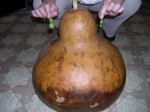|
|
|||
|
[an error occurred while processing this directive] |
|
|
|
|
|
|||
Not wanting to waste any available space, including the fence line bordering the state highway on our farm, we covered the fence with an array of smaller gourds which were cross pollinated by natural means. This gives us surprises, and we love surprises. This fence line did not disappoint us as we did gather a variety of unusual shapes, and roughly 500 gourds. |
|||
Dan's favorite of all gourds, the Japanese Hyakunari. Ideally shaped for a lidded box, nearly perfect size for a trinket box. The gourd while not being a mini gourd is still small enough to successfully oven dry, (see our gourd report on experimental methods of drying gourds), which leaves a nice light skinned gourd without the mold markings which is perfect for wood burning images, (Dan's favorite art form)
|
|||
Another Sample of Hyakunari's growing together within our trellis. Hyakunari's are also ideal for trellis growing, they are not too heavy for the stem and vine, yet they are large enough to make functional containers.
|
|||
This is our Hyakunari trellis. Simply built, we were given a couple of heavy duty cattle panels, constructed in a four inch square grid of thick galvanized metal wire. These panels are 52 inches tall and 15 feet long and very sturdy, (unlike typical cattle fencing). With some significant effort, we managed to bend a matching curve in the center of both panels with about a 1.5 foot radius curve, (3 ft. diameter, or in this case width), and using four metal fence line stakes for each panel, we rigged this nice little gourd trellis.
|
|||
This is a view inside the trellis. Roughly 9 ft long and 6 1/2 feet high, the trellis makes an ideal gourd trellis allowing gourds like Hyakunaris and other small to med. sized gourds to hang and grow naturally without curving the bottle neck at the top of the gourd. By the end of the season the top and sides of this trellis were covered rather well with Hyakunari's.
|
|||
This fence line borders a corn field and we utilized this for the growth of some Japanese Sennari's. We had some insects last year that damaged our Sennari vines, and our success rate with the Sennari's last year was minimal, though we did gather some nice gourds from the vine despite the insects. |
|||
This is one of our African Zulu's. The orange marker tape is marking it with it's cross pollination data. If you grow many gourds and either hand pollinate for purity or cross pollinate for experiment, it is good practice to mark each gourd securely so that accurate handling and isolation of your seed gourd from the rest of the gourds at harvest can be achieved easily.
|
|||
[an error occurred while processing this directive]
